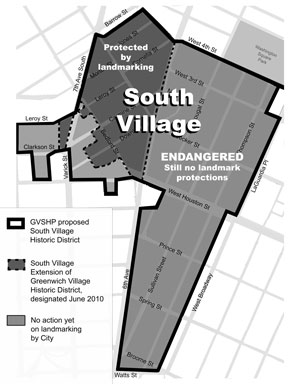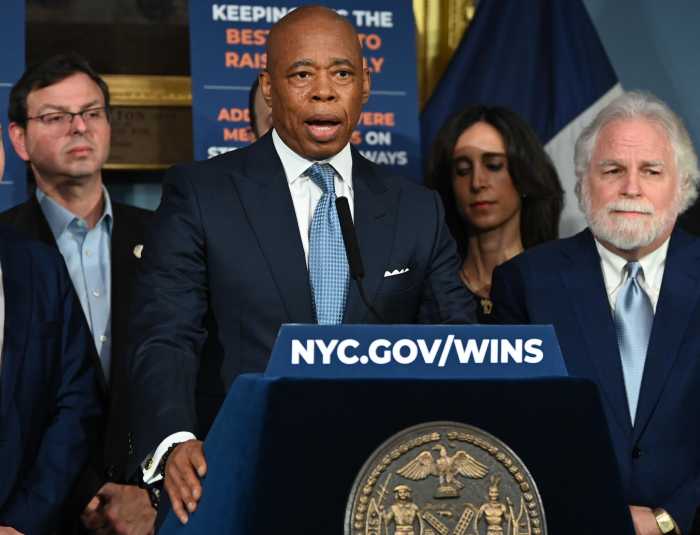 The Hudson Square rezoning currently before the City Council presents a rare case where a win-win is possible. Done right, the outcome could please everyone — developers and community groups, residents and businesses. Unfortunately, the rezoning plan also presents the possibility of a lose-lose for the community. One person will decide which of these outcomes we get — City Council Speaker Christine Quinn, in whose district the proposed rezoning lies.
The Hudson Square rezoning currently before the City Council presents a rare case where a win-win is possible. Done right, the outcome could please everyone — developers and community groups, residents and businesses. Unfortunately, the rezoning plan also presents the possibility of a lose-lose for the community. One person will decide which of these outcomes we get — City Council Speaker Christine Quinn, in whose district the proposed rezoning lies.
There is a rare consensus that Hudson Square’s current zoning should be improved. The current zoning allows out-of-scale development like the Trump Soho condo hotel, and makes hotels the most attractive kind of development. Trinity Real Estate, a developer which owns 40 percent of the property in the neighborhood, has proposed a rezoning that has been approved by the borough president and the City Planning Commission, and now must be approved by the City Council.
If some important changes were made to the rezoning, we could all support it too. But our support for the rezoning, and the rezoning doing more good than harm, is also very much contingent upon the city putting in place long-promised landmark protections for the adjacent South Village neighborhood. The South Village will experience increased development pressure and accelerated demolition and inappropriate new development if the rezoning is approved without the landmarking as well.
The proposed rezoning would introduce residential development to Hudson Square for the first time. All sides agree this will result in a good deal of new development in Hudson Square that would not otherwise take place. But under the current proposal, the height and density of allowable proposed development would be more typical of Midtown Manhattan, putting added pressure on local infrastructure, increasing traffic and allowing new towers much taller than in most of the existing neighborhood. That’s why many of us have urged that the allowable height of new construction in Hudson Square be reduced by about a third, to 210 feet, and that the bulk of most new development be reduced by about a quarter.
But in some ways, the impact of the Hudson Square rezoning would be most powerfully felt not in Hudson Square itself, but directly across Sixth Ave. in the South Village. This low-rise, residential neighborhood, stretching from Washington Square to Watts St., is one of New York’s most historic, and currently one of its most threatened.
Once Hudson Square goes from sleepy backwater to hot new neighborhood, you can bet the South Village will feel the heat as well.
Advocates have been seeking to have the area landmarked since the 1960s, and a concerted effort to get the city to finally grant landmark protections to the neighborhood has been ongoing since the early 2000s. In 2009, the city began the process of landmarking about 30 percent of the South Village, focusing on its northwesternmost corner. At the time, the city promised to consider the remainder of the neighborhood shortly thereafter.
It still has not done so, however, and the South Village has suffered greatly for it. The landmarking effort was spurred in part by New York University’s demolition of the neighborhood’s Judson House and Edgar Allan Poe House in the early 2000s. Since then, N.Y.U. has also demolished almost the entire Provincetown Playhouse and Apartments, and in the last few years developers have razed 19th-century houses on Bleecker St. and Spring St. and lower Sixth Ave. The Children’s Aid Society’s campus on Sullivan St., including its 1891 Calvert Vaux-designed main building, is being gutted and transformed into condos. New towers as high as 18 stories are planned on sites next to four- and five-story buildings.
Unfortunately, this process has appeared to accelerate in anticipation of the Hudson Square rezoning, and it will clearly only get worse once the rezoning is enacted.
Trinity’s intention is to turn Hudson Square into a “vibrant, 24-hour-a-day neighborhood” with new, luxury high-rise apartment buildings and a lively and attractive mix of retail — the new “it” neighborhood. There are a limited number of potential development sites within Hudson Square: Much of the neighborhood is built up with large, older loft buildings that can’t be demolished. However, the low-rise South Village directly across Sixth Ave. is quite ripe for demolition and new development.
Once Hudson Square goes from sleepy backwater to hot new neighborhood, you can bet that the South Village, on its doorstep, will feel the heat as well. And we are not the only ones who think so — the city’s own environmental analysis of the proposed Hudson Square rezoning said that while the South Village was “landmark-eligible,” it would suffer “significant adverse impacts” if the rezoning was passed and landmarking was not.
But the die is not yet cast. Though the city has given its approval to the Hudson Square rezoning and made clear that it has no intention to landmark the South Village anytime soon, Speaker Quinn holds all the cards.
She has tremendous leverage over City Hall and the Landmarks Preservation Commission; the mayor can pass no legislation without the Council’s approval, and all of the commission’s designations, and its funding, must be approved by the Council as well. And City Hall wants the Hudson Square rezoning to pass. Speaker Quinn has used her leverage in other such rezoning applications to get the city to provide millions in funding for schools and affordable housing it had previously resisted, as well as to move ahead with a historic district. So there’s good reason to believe that if she wanted to, she could get the city to do the same here.
But even if this is the rare and inexplicable case where the city — in spite of the speaker’s best efforts and use of her political leverage — absolutely refuses to move ahead with landmark designation, Speaker Quinn still holds all the cards. She must also approve the rezoning, and she can turn it down if City Hall refuses to budge on landmarking the South Village. This would prevent irreversible damage from happening to the South Village, which would be the inevitable result of passing the Hudson Square rezoning without landmarking. And Trinity could come back in six months, or a year, or however long it takes to convince the city that landmarking the South Village is essential, particularly for allowing passage of the Hudson Square rezoning, which will otherwise accelerate the South Village’s destruction.
Speaker Quinn, it’s all up to you. You have the power to create the win-win that the administration has refused to — demand South Village landmarking as a condition for approval of a modified, reasonable, Hudson Square rezoning. And if the administration says no, we need you to stand with your constituents, and the neighborhood you represent, and say no as well. Don’t approve this rezoning that will hasten the undoing of the South Village unless the long-promised and much-needed landmark protections are approved also.
Berman is executive director, Greenwich Village Society for Historic Preservation; Bordonaro and Winestine are co-chairpersons, Greenwich Village Community Task Force; McGee is a member, South Village Neighborhood Association; Blodgett is president, Charlton St. Block Association; Rosenstein is a member, Broome St. Block Association; Beam is president, Vandam St. Block Association
— By Andrew Berman, Katy Bordonaro, Zack Winestine, Micki McGee, Richard Blodgett, Carl Rosenstein and Silvia Beam





































